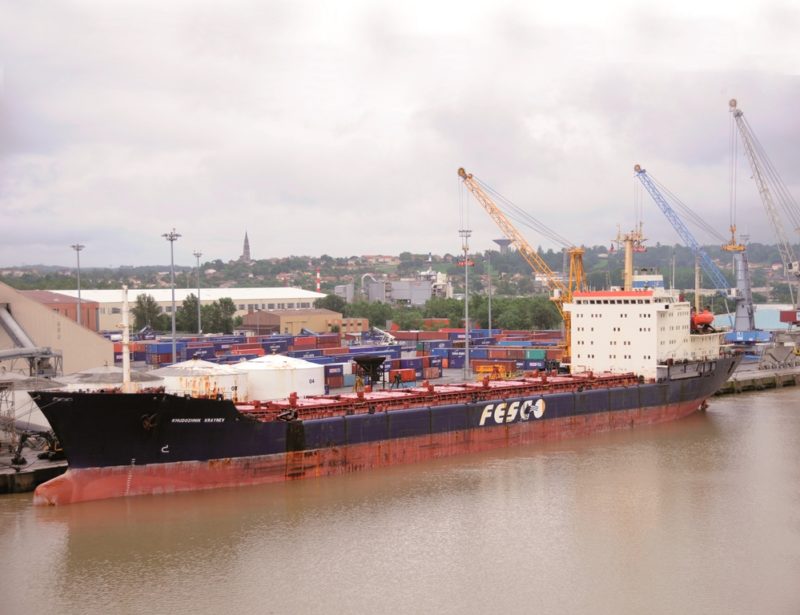
The Port of Bordeaux consists of seven ports or outports on the Gironde estuary in Pauillac, Le Verdon, Blaye, Ambes, Grattequina Terminal, Bassens and Bordeaux. The total cargo throughput per annum today of all seven ports is between 7.0 million and 8.0 million tonnes per year. After Marseille, Bordeaux is the oldest French trading port, it has exported wine from Roman times and has always based its trade on wines and agricultural products. English rule between 1154 and 1453 AD saw merchants making immense fortunes from wine sales to England. After the discovery of the New World in 1492 by Cristopher Columbus, Bordeaux took advantage of its Atlantic position on the Bay of Biscay to diversify and extend its wine markets. The barrels of wine were transported down the Dordogne and Garonne rivers to Bordeaux in small craft propelled by oars and wind driven by square sails.
Today, the Bordeaux region produces over 60 million cases of wine per year. Some of the most celebrated wines in the world are made in and around Bordeaux, which is the largest fine wine producer in the world with many of them taking their names from towns in the region e.g. St. Emilion, Medoc, Sauternes, Pomerol, Margaux and the fortified and distilled wine known as Cognac brandy as well as liqueurs. The many wine chateaux of the Aquitaine and Charente regions near the Garonne and Dordogne rivers hold wine tastings during the summer months, and there are wine tasting sessions in the summer in the village of St. Emilion in its shops.
Bordeaux produces both white and red wines, but it is particularly noted for its red wines, growing high class, more expensive Cabernet Sauvignon grapes on the left bank of the Garonne to the west of Bordeaux. Merlot and Cabernet Franc based wines are grown on the right (east) bank, and there are also some very good white wines mainly from the Pessac and Graves villages to the south and south east of Bordeaux, with most white wines based on Sauvignon Blanc grapes in both the sweet and dry forms.
Wine is exported from Bordeaux by wine tanker, and also in large wooden cases containing hundreds of bottles stuffed into containers. The extent of the wine growing is massive, with 287,000 acres of vineyards, 57 appellations, ten thousand wine growing estates (chateaux), 13,000 grape growers and 6,300 wine producers. The Premier Cru (first growth) red wines include four types from Medoc, and one from Graves known as Chateaux Haut-Brion, and were established by the Bordeaux Wine Official Classification of 1855. Bordeaux is home to the largest wine fair in the world, Vinexpo, and the wine industry in the Bordeaux area is worth 14.5 Euro billions per year, with premium wines such as Chateaux de Cartillon retailing from £12.99 per bottle and other premium wines being more expensive. No fewer than twenty one bottles of Bordeaux wine are sold every second to countries all across the world.
Bordeaux is known for its very beautiful Gothic Cathedral of Saint Andre, consecrated by Pope Urban II in 1096, but only a wall remains in the nave of the original Romanesque building. The Royal Gate is from the early 13th century, while the rest of the building is from the 14th and 15th centuries. The Church of the Holy Cross (Eglise Sainte Croix) lies on the site of a 7th century abbey destroyed by the Saracens but rebuilt under the Carthaginians and again destroyed by the Normans in 845 and 864 AD. It is annexed to a Benedictine abbey founded in the 7th century and was built in the late 11th and early 12th centuries. The most ancient church in Bordeaux is the Basilica of Saint Seurin, built in the early 6th century on the site of a paleo-christian necropolis. It has an 11th century portico with the apse and transept from the next century. The 13th century nave has chapels from the 11th and 14th centuries, and the ancient crypt houses sepulchres of the Merovingian family.

The Medieval walls of the city date from the 15th century and include La Porte Cailhau and La Grosse Cloche, a remaining gate that housed the belfry of the old Town Hall consisting of a 131 feet high circular tower and a central bell tower housing a bell weighing in at 17,200 pounds that dates from 1759. Many 18th to 19th century mansions, as well as some notable art museums such as the Musee des Beaux Artes de Bordeaux are to be found in the city. Public gardens line the curving river quays, and the grand Place de la Bourse overlooking the river is centred on the Three Graces fountain overlooking the Miroir d’Eau reflecting pool and its surroundings.
The Esplanade des Quinconces, the largest square in France, has the magnificent Column of the Girondins with fountains and cherubs set back from the river and built to celebrate the Triumph of Concord and the establishment of the French Republic, and is near the cruise ship berths. The Centre d’Art Plastique Contemporain (CAPC) is famous worldwide for major exhibitions of contemporary art, and has a collection of pioneering national and international works of art. The historic part of the city is a UNESCO World Heritage Listed city as an outstanding urban and architectural ensemble of the 18th century. Bordeaux has the highest number of preserved historical buildings of any city in France, including Paris.
The ‘Triangle d’Or’ is an area near the excellent neoclassical Grand Theatre of 1780, built on dimensions of 290.0 feet by 155.0 feet and designed by Victor Louis (1731-1811) with statues of the nine muses and the goddesses Juno, Minerva and Venus, and near a large number of fashionable Parisian boutique shops. King Louis XV employed the architect team of Gabriel father and son to design and build the city with the best architecture in France. The 18th century architecture, wine tourism and beach holidays make Bordeaux one of the most sought after destinations in France.
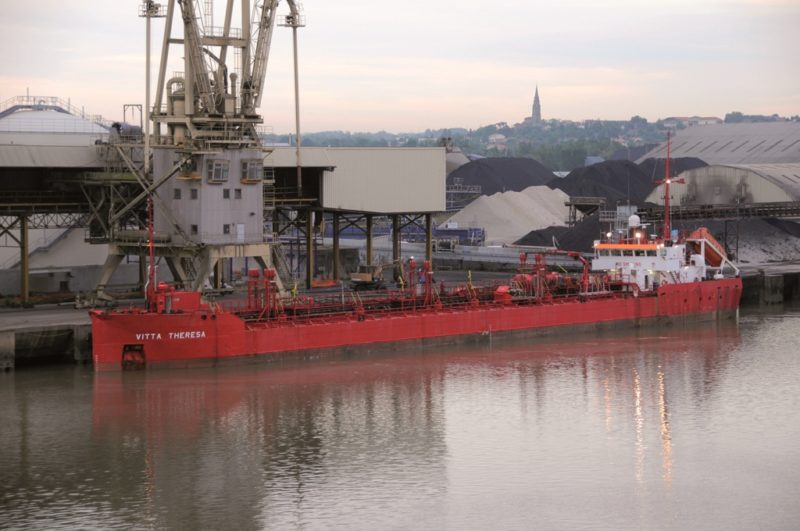
HISTORY OF BORDEAUX
The founding tribe of the Aquitaine region were Celts around 567 BC known as the Burdigala, who fought a battle with the Romans in 107 BC who were defending another Gallic tribe, the Allobroges allied to Rome. The Romans were defeated and their legionary commander, Lucius Cassius Longinus, was killed in battle. Fifty years later, the Romans returned and took control of the area, mining tin and lead. Bordeaux was the capital of Roman Aquitaine until it was sacked by the Vandals in 267 AD and again in 409 AD, followed by the Visigoths in 414 AD, the Franks in 498 AD, but after this last occupation the city fell into obscurity during ‘The Dark Ages’.
The fortifications and the Aquitaine Army of Bordeaux were overwhelmed in 732 AD by the Arab Umayyad Army of Abd el Rahman. Duke Eudes of Aquitaine fought bloody battles on two occasions near the Garonne river with the Umayyads with high death tolls, but after the Battle of Poitiers he fortunately retained his grip on Aquitaine. Wars continued unabated, however, against the Basques and the Vikings, who appeared with their longships in the Gironde Estuary in 844 AD, and the latter captured and executed Count Seguin II of Bordeaux in the Autumn of 845 AD.
English rule from the 12th to the 15th centuries resulted from the marriage of Duchess Eleonore of Aquitaine to Count Henri Plantagenet, born in Le Mans, who within months of their wedding became King Henry II of England. The wine trade increased in importance with wine sales to England and the Cathedral of Saint Andre was built in Bordeaux. However, after the Battle of Castillon in 1453, Aquitaine was annexed by France, with fortified chateaux and forts built by King Charles VII of France as potent symbols of the new regime.
Wine exports to the newly discovered Americas and the West Indies during the 15th and 16th centuries increased the importance of Bordeaux, and the French Army of King Louis XIV entered the city in 1653, manifestly displaying the might of the Kingdom of France. However, the 18th century was the century of the golden age of Bordeaux, with five thousand splendid town houses built in the city and along the quays of the port. The Prefect of Bordeaux at this time was none other than Baron Haussmann (1809 – 1891), who used this large scale remodelling of Bordeaux to later transform the city of Paris into a ‘modern capital’ of which France could be very proud.
During the Peninsular War of 1807 to 1814, King Carlos IV of Spain and his relatives abdicated the throne and issued a proclamation at Bordeaux on 12th May 1808 absolving all Spaniards of loyalty and obligations to the monarch, and continued on to internment at Talleyrand’s country estate at Valencay and the personal imprisonment of Napoleon Bonaparte. Towards the end of the Peninsular War on 12th March 1814, the Duke of Wellington sent William Beresford with two divisions of the English Army to capture Bordeaux and encountered little resistance. Bordeaux was largely anti Bonaparte and the majority of the population supported the Bourbon family, so the British troops were welcomed as liberators.
In 1870, at the start of the Franco Prussian War, the French Government temporarily relocated to Bordeaux from Paris. This occurred again during the First World War, and again very briefly during World War II, when it became clear that Paris would fall into German hands. However, the Vichy Government allied to the Nazis took control of Southern France including Bordeaux, which was the scene in June 1940 of the life saving actions of the Portuguese Consul General, Aristides de Sousa Mendes, who illegally granted thousands of Portuguese visas to Bordeaux citizens to pass across the Spanish border after fleeing the encroachment of German troops.
The ‘Cockleshell Heroes’ or Operation Frankton attacking German shipping in Bordeaux on 7th December 1942 was a true story of commando raids, as Major Stringer of the Royal Marines believed it was possible for commandos in collapsible canoes to reach the enemy held harbour undetected and blow up ships with limpet mines. Five two-man canoes were launched from the ‘T’ class submarine Tuna close to the mouth of the Gironde, and reached Bordeaux after 70 miles of hard paddling upriver in freezing conditions in their Mark II ‘Cockle’ canoes. Limpet mines were planted on a number of German ships from four canoes that reached their target. The raid was successful in that mines exploded at 2100 hours on the 11th December on four ships on the west side of the Garonne and two ships on the Bassens east side. One ship was severely damaged and unrepairable while five others were slightly damaged and repaired in dry-dock. Louis Mountbatten in a letter to the commandos said ‘The operation was carried through with great determination and courage’. There is one surviving ‘Cockle’ canoe together with other original equipment at the Combined Military Services Museum at Maldon in Essex.
A heavily fortified set of submarine pens was built at Bordeaux between 1940 to 1943 to shelter German U-boats and those of the Italian Royal Navy from R.A.F. high level bombing. The German 12th U-boat flotilla was a formidable quarry for the Royal Navy convoy escorts in the Battle of the Atlantic, but after March 1943 due to new weapons developments such as ‘Hedgehog’ apparatus throwing depth charges in a wide pattern to the exact positions of the illuminated Asdic equipment displays of the escorts giving pinpoint accuracy of the depth and position of the U-boat, the U-boat menace was defeated once and for all. Large numbers of German commerce raiders, liners and cargo ships of all sizes were scuttled and abandoned in the Gironde estuary in August 1944 as German forces retreated north and east to escape of the advances of Allied Armies. French ships had been requisitioned for all manner of use by the Nazis, and were also sunk, and the salvage effort to clear the channel into the Gironde estuary between Royan on the east bank and Le Verdon on the west side and up to Bordeaux took years to complete.
Bordeaux has a temperate oceanic climate with on average 37.17 inches of rain per year, and 2,036 hours of sunshine per year due to the influence of the Gulf Stream passing through the Bay of Biscay with a summer temperature averaging 21 to 22 degrees Centigrade. The surroundings of the Garonne river at Bordeaux are flat, and the Garonne river and the Gironde estuary are normally calm, allowing the vehicle and passenger ferries from Royan on the east bank to Le Verdon on the west bank to cross the Gironde Estuary year round without any interruptions to service.
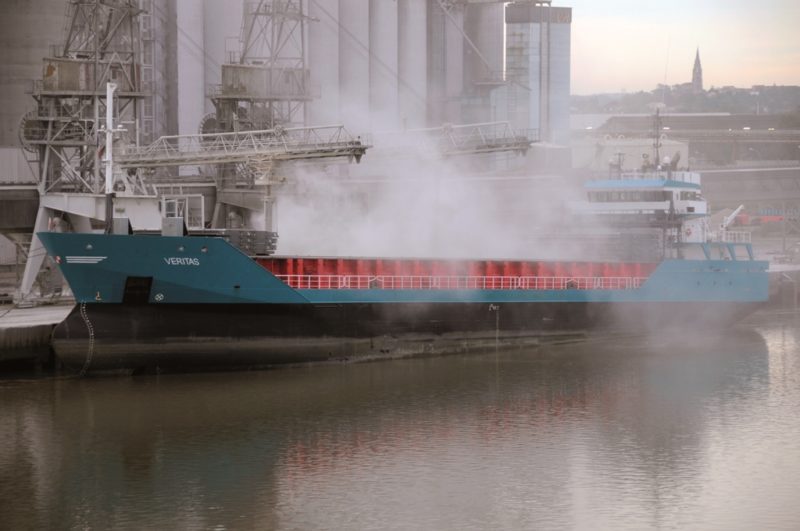
PORT OF BORDEAUX
The Port of Bordeaux is sometimes known as ‘The Port of the Moon’ from the city motto that reads ‘The fleur de lis alone rules over the moon, the waves, the castle and the lion’. The Port of Bordeaux itself covers around 140 hectares of land, with the seven ports on the Gironde covering around 1,500 hectares of land, and they have very different trades and histories:-
PAUILLAC handles 710,000 tonnes of imports and exports per year, and handles Airbus A380 airframes, wings, components and parts arriving by sea from England, Germany and Spain, which are transferred to barges that transport them to Langon, and they are then taken to Toulouse for final assembly. Pauillac is the largest and most attractive town in the Medoc region, with the port handling oil and timber cargoes.
LE VERDON handles 210,000 tonnes of imports and exports per year, and has three berths, two container cranes, one ro-ro ramp with an alongside depth of 12.5 metres. There is a warehouse of 12,000 square metres, and there are 60 hectares of Free Zone, and the Terminal Container South West (TCSO) is a very modern container terminal opened in 1976 for handling containers and timber with simplified customs procedures and tax benefits. Two ferries, La Gironde and L’Estuaire, of dimensions of length 78.0 metres and moulded beam of 18.5 metres have capacities for 600 foot passengers and 140 cars or combinations of six trucks and 92 light vans for the route from Le Verdon to Royan. The estuary dredger is La Maqueline, and the estuary tugs include TSM Drenec of 300 grt, RM Medoc of 270 grt, and RM Thomas of 286 grt of Compagnie Towing Maritime Bordeaux-Bassens.
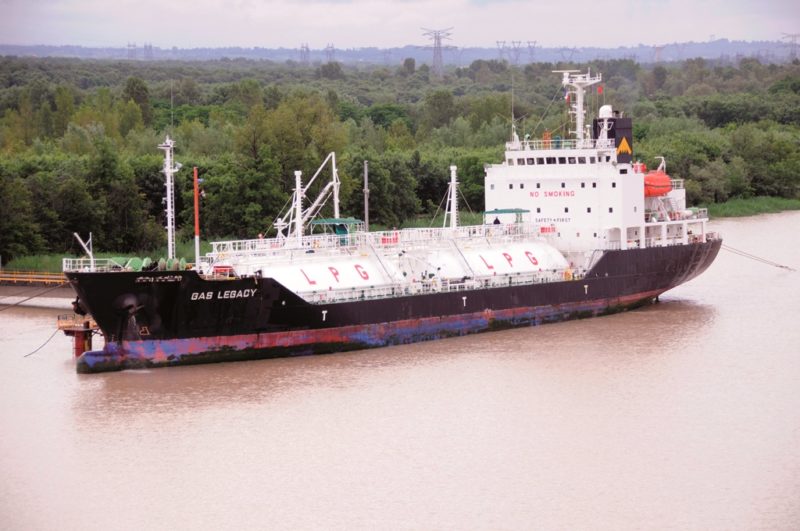
BLAYE on the right (east) bank handles 290,000 tonnes of imports and exports per year, and its main trades are the export of cereals and the import of liquid bulk oil and chemical cargoes.
AMBES handles 3.9 million tonnes of cargo per year and is the largest petrochemical port in South West France handling crude oil, gasolines, gas oils, domestic fuel oils, and other grades of fuel oil and chemicals.
GRATTEQUINA TERMINAL handles aggregates cargo at a single long multi purpose wharf near the centre of Bordeaux, as well as occasional project cargo for the six hectares of logistics and industrial companies located nearby.
BASSENS handles 3.2 million tonnes of cargo per year including multi bulk cereals, grain, containers, forestry products and project cargo at three kilometres of wharves on the right bank of the Garonne.
BORDEAUX used to handle cargo at its old traditional Basin Number 1 and Basin Number 2, with Number 1 entered first from the Garonne in order to access Number 2 Basin, but now they are only used by yachts and small craft. The port headquarters, finance office, warehouses and four river berths for cargo handling are just downstream of the entrance to Number 1 Basin. Large cruise ships berth further up the river on the same west side at a berth with the twin towers of the Esplanade des Quinconces as a backdrop on the magnificent Quai Louis XVIII. There are also cruise overflow berths at Bassens and Le Verdon. There is the large Jacques Chaban-Delmas lifting bridge just upstream of the main port cargo facilities with a central lifting section that rises 117 metres to allow cruise ships to pass through to the Esplanade des Quinconces berths. The upper limit to navigation to shipping except barges is called the Pont de Pierre, upstream of the twin towers of the Esplanade des Quinconces.
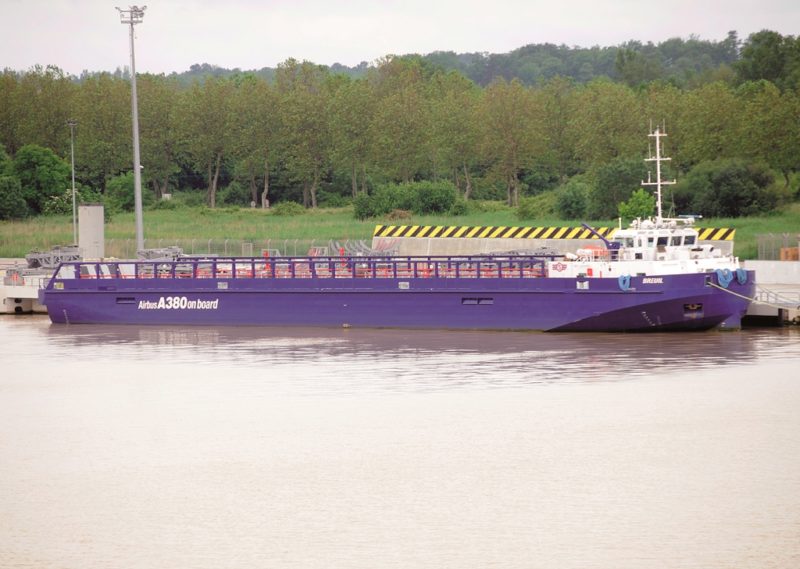
The GPD of Bordeaux is Euro 32.7 million from its many businesses and factories in the area, valued as the sixth largest Metropolitan business area in France, with 260,000 people living in the central Bordeaux city area. The main businesses that generate imports and exports for the Port of Bordeaux include the following :-
AIRBUS uses three special ro-ros to import components at Pauillac in Ville de Bordeaux of 21,538 grt on dimensions of length 154.0 metres, moulded beam of 24.0 metres and a draft of 5.7 metres and built by the Jinling yard at Nanjing in China at a cost of $30 million. She began operations on 10th June 2004 and is registered at Bordeaux on a regular run from Hamburg with front and rear sections of the fuselage and then heads to the U.K. to load the wings at Royal Portbury Docks and manufactured at Filton (Bristol) as well as other components at Mostyn manufactured at Broughton (Flintshire). At Montoir (St. Nazaire) she trades the fuselage sections from Hamburg for larger completed sections including the nose for delivery to Pauillac. She also heads south to Cadiz to load belly and tail sections manufactured by Construcciones Aeronauticas S.A. also for delivery to Pauillac.

Two slightly smaller ro-ros also operate on this route for Airbus, in the sisters City of Hamburg and Ciudad de Cadiz of 15,643 grt on dimensions of length 127.0 metres and a moulded beam of 21.0 metres, and completed in Singapore in August 2008 and April 2009. The trio are all owned jointly by Louis Dreyfus Armateurs and Leif Hoegh of Norway, and are operated by their subsidiaries of Fret and Cetam on twenty year leases with an extension of another ten years. The Toulouse factory of Airbus produces four completed aircraft per month, which then fly to Hamburg for painting and handover.
Le Belier S.A. is the leading producer of aluminium based automotive and aeronautical braking systems in the world. It was founded in 1961 at Verac, a small village in the heart of the Bordeaux wine growing region less than 25 kilometres from Bordeaux city centre. The founding Gallard family had owned vineyards since the late 1930s and grew the business to make braking systems and components for large worldwide companies such as Airbus, Audi, General Motors, Fiat, Bosch Bari and Magnetti Marelli.
The aeronautic industry of Bordeaux region employs 20,000 people in some of the biggest companies including Dassault, EADS Sogerma, Snecma (Safran Aircraft Engines manufacturer), Thales, SNPE and others. The Dassault Falcon private jets are built in Bordeaux as well as the Mirage 2000 and Rafale military jets, the Airbus A380 cockpits, and the engine boosters of the Ariane 5 space rockets launched from French Guyana in South America, and large ballistic missiles and sea to air missiles such as the French M51 ballistic missile. Dassault was established in 1929 by Marcell Dassault, and today also manufacture many types of aerospace equipment, electric and plug-in hybrid vehicles, and integrated logistical support systems.
Laser technology is well established in the Bordeaux area, with the Laser Megajoule one of the most powerful lasers in the world manufactured here with the help of the French Ministry of Defence and an investment of Euro 2 million. The Bordeaux area has the most important concentration of optical and laser expertise in Europe, manufacturing all types of lasers including gas lasers and helium neon lasers, carbon dioxide lasers, chemical lasers, solid state lasers including red ruby lasers, fibre lasers, photonic crystal lasers, semiconductor lasers, dye lasers, free electron lasers, and high quantum energy lasers for industrial and medical uses.
The pharmaceutical industry is well established in the Bordeaux region with the American McKesson Corporation and the Sanofi Aventis companies making medical supplies and drugs including prescription drugs. Other industries include the Pernod and Ricard aniseed flavoured drinks and alcoholic beverages, clothing manufacturers, large corrugated packaging and paper based packaging, and electronics manufacturer Solectron manufacturing solar energy equipment.
The tourism industry benefits from the ‘Blue Flag’ tourist beach areas at the salt water Bassin d’ Arcachon as well as Etang de Hourtin to the west and south west of Bordeaux with traditional beach water sports and pursuits to rival the scale of tourism on the wine trails of Bordeaux and the Aquitaine and Charente regions of France. The finest Atlantic beach near Bordeaux is at Lacanau Ocean with a beautiful lake and world class surfing facilities.
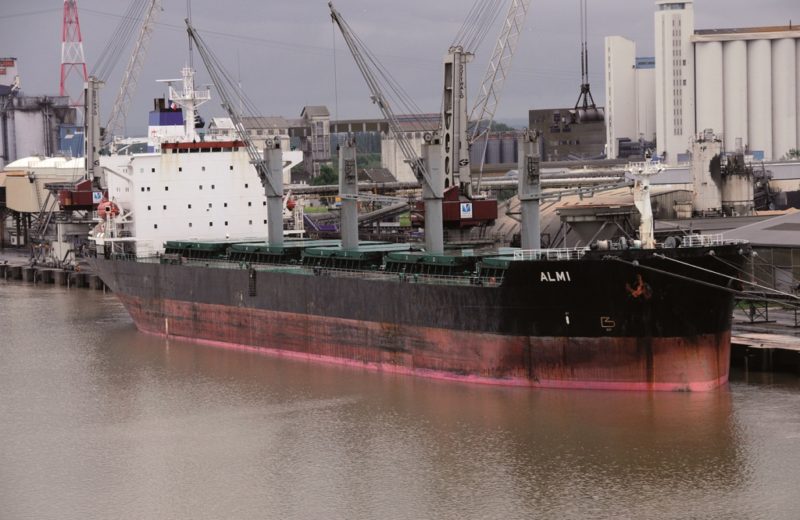
SHIPPING COMPANIES with BORDEAUX CALLS
Bordeaux because of its south west position in France was the main departure point for all liner shipping heading to South America, the Caribbean and Central America, and the Eastern Seaboard of the U.S.A. including New York. There were many French shipping companies that used Bordeaux as their base, or as a port of call after sailing from Le Havre and Bay of Biscay ports such as Saint Nazaire, Nantes and La Rochelle. The shipping companies included:-
MESSAGERIES MARITIMES
A Bordeaux to South American ports was operated between 1860 and 1912, at first just to two ports in Brazil with the coastal feeder ships Aunis and Saintonge running from Rio de Janeiro to Santos, Montevideo and Buenos Aires, until the Plate estuary and its two main ports were deepened for larger ships. The service was established by decree of the Administration des Postes, however Messageries Imperiales (Messageries Maritimes became the new name of the company on the deposition of the French King in 1871) did not like the service as it involved setting up a separate operating unit in Bordeaux.
The passenger and cargo vessels known to have been used on this service included Guienne of 1860, Rio Grande of 1860, Estamadura of 1860, Bearn of 1860, Tigre of 1862, Erymanthe of 1862, Hooghly of 1868, Gironde of 1869, Amazone of 1870, Uruguay of 1870, Niger of 1872, Orenoque of 1874, Equateur of 1875, Parana of 1876, Congo of 1878, the twin funnelled Portugal of 1887, Dordogne of 1889, Charente of 1889, the twin funnelled La Plata of 1889 and Bresil of 1890 and the twin funnelled Chili of 6,395 grt that made her maiden voyage from Bordeaux to South America on 5th August 1895. The latter ship sank at her berth in Bordeaux on 23rd April 1903 after water had entered her hull, and she came to rest at an angle of 45 degrees against the quay with her keel stuck in mud. She was refloated and towed to a dry dock in Bordeaux on 24th July 1903 for repairs, with all of her furnishings replaced. Amazone of 1896, Magellan of 1897, and Atlantique of 1900 were her twin funnelled sisters, and the fastest ships on the route until it closed in 1912.
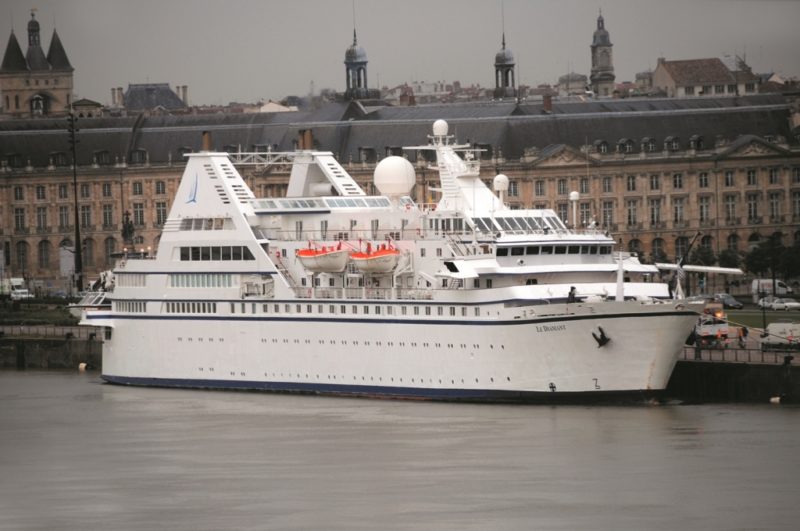
COMPAGNIE de NAVIGATION SUD ATLANTIQUE
This company was formed on 8th February 1912 and took over the South American services from Bordeaux of Messageries Maritimes on 22nd July 1912, and built or purchased four passenger liners of 18 knots service speed with a minimum length of 175.0 metres, as well as six smaller passenger cargo-liners in order to maintain a fortnightly mail service from Bordeaux to Buenos Aires. The three funnelled Lutetia of 14,783 grt was completed in 1913 by Chantiers de l’Atlantique at Saint Nazaire, while her sister Gallia of 14,966 grt came from the La Seyne yard of Forges et Chantiers de la Mediterranee in 1913. A third sister was also laid down but was incomplete at the start of World War I, when work stopped to be resumed in 1919 and completed in 1920 as Massilia of 15,147 grt at La Seyne. Due to delays, the German liner Kaiser Friedrich of 12,480 grt was purchased in 1912 to start the service as Burdigala via Vigo and Lisbon to Rio de Janeiro, Santos, Montevideo and Buenos Aires. Massilia had a service speed of twenty knots from triple expansion steam engines with twin low pressure turbines and quadruple propellers generating 26,000 shp, and was equipped with four electric cranes and four derricks for cargo handling.
The smaller sextet of passenger cargo-liners were renamed as Alesia (ex La Bretagne of French Line, Divona (ex Ormuz), Garonna (ex Avondale Castle), Liger (ex Tintagel Castle), Samara (ex Staffordshire) and Sequana. The most famous liner in the fleet was the large liner L’Atlantique of 42,500 grt completed in 1931 by Chantiers de l’Atlantique at St. Nazaire which made her maiden voyage from Pauillac (Bordeaux) on 29th September 1931 to South America. She made ten round voyages from Pauillac before her loss on 4th January 1933 by fire in the English Channel while moving from Pauillac to Le Havre for repairs, and she was broken up at Port Glasgow. Pasteur of 29,253 grt was completed at St. Nazaire in 1939 but was immediately taken over for war service by the U.K. and managed by Cunard White Star Line for trooping. She was returned to her owners in 1945 but with falling passenger numbers she was sold to Norddeutscher Lloyd in 1957 and renamed Bremen.
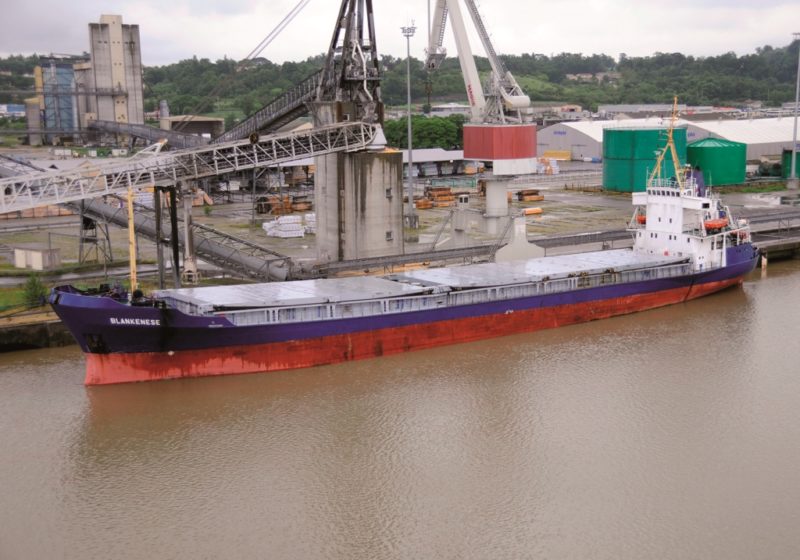
COMPAGNIE des CHARGEURS
REUNIS
Compagnie de Chargeurs Reunis took over Compagnie de Navigation Sud Atlantique in April 1916 and managed the South American services from Bordeaux, and also took over their slower intermediary service to South America in 1928. The Swan, Hunter and Wigham Richardson Ltd. yards built the passenger liner sisters of Mosella and Meduana of 10,123 grt, completed during 1922/23, which were transferred to Chargeurs Reunis in 1928 from Sud Atlantique and renamed as Jamaica and Kerguelen. Meduana had a disastrous fire and capsize during fitting out at Wallsend that delayed her completion by six months. The post war South American services from Bordeaux were operated by Pasteur of 1939 and three sisters of 12,300 grt completed in 1951/52, with two under Compagnie de Navigation Sud Atlantique as Laennec and Charles Tellier, and sister Louis Lumiere under Chargeurs Reunis. On 20th September 1962, both Sud Atlantique and Chargeurs Reunis gave up their passenger sailings, and the trio were transferred to the ownership of Messageries Maritimes but continued on the same service from Bordeaux. The South American service finally closed down in 1966, with Sud Atlantique wound up later in that year, and the trio were sold for the Moslem pilgrim service.
COMPAGNIE GENERALE
TRANSATLANTIQUE (FRENCH LINE)
French Line ran a regular Transatlantic service from Le Havre and Bordeaux via Vigo to New York, Baltimore and New Orleans, as a well as a service from the two French ports to Canadian ports. French Line had operated a huge fleet of liners and cargo-liners since the brothers Emile and Isaac Pereire had founded the company in 1854, and the Transatlantic service from Bordeaux was run in collaboration with Chargeurs Reunis. Passenger and cargo ships on this service included Bordeuax and Pauillac, former British ships, and on the Bordeaux to Casablanca route the beautiful clipper bowed Voubilis of 4,747 grt ran with accommodation for 140 First Class passengers,72 in Second Class and 80 in Third Class and had been built by William Beardmore on the Clyde for Far East service in 1902. She ran on this direct service with the Clyde built twin funnelled Versailles of 4,247 grt and purchased in 1889. This service was part of the longer service from Bordeaux to Port Lyautey, Mohammedia, Casablanca, Mazagan, Safi, Mogador, Agadir, Essaouira and other French Moroccan and North African Atlantic ports.
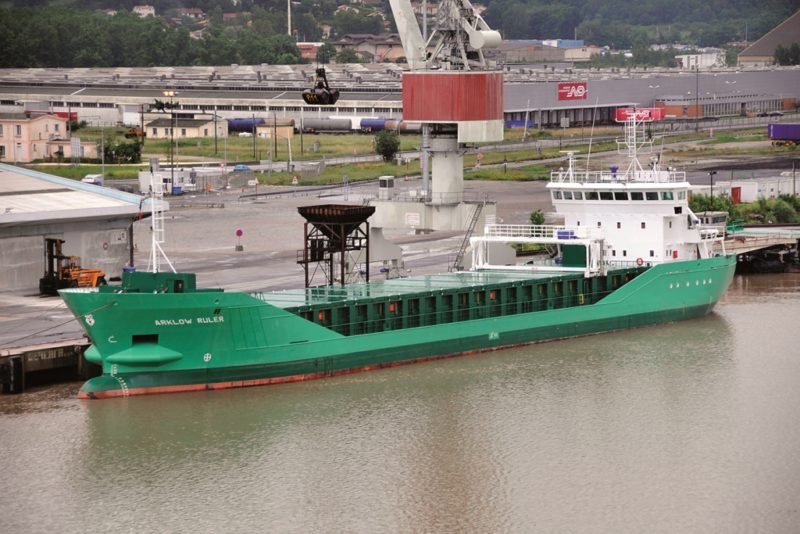
COMPAGNIE de NAVIGATION
D’ORBIGNY
This company had been steamship owners since 1878 and was previously styled as Compagnie de Navigation d’Orbi et Faustin. It operated ships on the route from Hamburg, Rotterdam, Dunkirk, Le Havre, Rouen, Nantes, Bordeaux, Vigo, Lisbon to the South American ports of Recife, Salvador, Rio de Janeiro, Montevideo and Buenos Aires. A parallel service ran from the Mediterranean to the Amazon ports of Belem, Manaus and Fortaleza. The company ship names had the suffix ‘on’ e.g. Ablon, Arzon, Chalon, Chinon, Criton, Crozon, Dijon, Fauzon, Gaillon, Gazcon, Lannion, Meudon, Moron, Platon, Redon, Salon, Sauzon, Strabon, Vernon and Vierzon. The controlling interest in the company was acquired in 1965 by Messageries Maritimes from Chargeurs Reunis and Louis Dreyfus et Compagnie, together with their last three ships Arzon, Salon and Sauzon. This trio continued in d’Orbigny black hull colours with red boot topping and black funnel colours with central red, blue and green bands, as part of the SEAS (Soc. Anon d’Exploitation de l’Atlantique Sud) consortium to South American ports, which continued after Messageries Maritimes became Compagnie General Maritime (CGM) in 1977.
BORDEAUX SHIPBUILDING and SHIPREPAIR YARDS
The Arman Brothers built ships at Bordeaux in the 19th century up to 1872, and the Ateliers et Chantiers de Bacalan from 1868 to 1879, becoming Dyle et Bacalan from 1879 to 1936. The Forges et Chantiers de la Gironde shipyard was located at Lormont near Bordeaux and had four building berths for building ships up to 630 feet in length and one dry dock of length 670 feet with a breadth at its entrance of 108.3 feet. The yard built mostly cruisers, destroyers, submarines and other warships for the French, Japanese and Ottoman navies. The Ateliers et Chantiers Maritimes du Sud-Ouest shipyard was located on Rue Archard in Bordeaux and had five berths capable of building ships up to 450 feet in length with a maximum annual output of 40,000 grt.
Today, the repair facilities at the Port of Bordeaux include the Bassens dry dock of length 240.0 metres by 35.0 metres wide, and two Bordeaux Bacalan dry docks of dimensions 150.0 metres by 22.0 metres, and 100.0 metres by 17.0 metres, and a slipway that can handle five small fishing vessels and other craft at the same time. CNB Yachts for building large yachts of national and international clients, and Chantiers Nicolas that build small wooden racing craft and other wooden boats, are now both in business on the sites of former defunct Bordeaux shipyards.
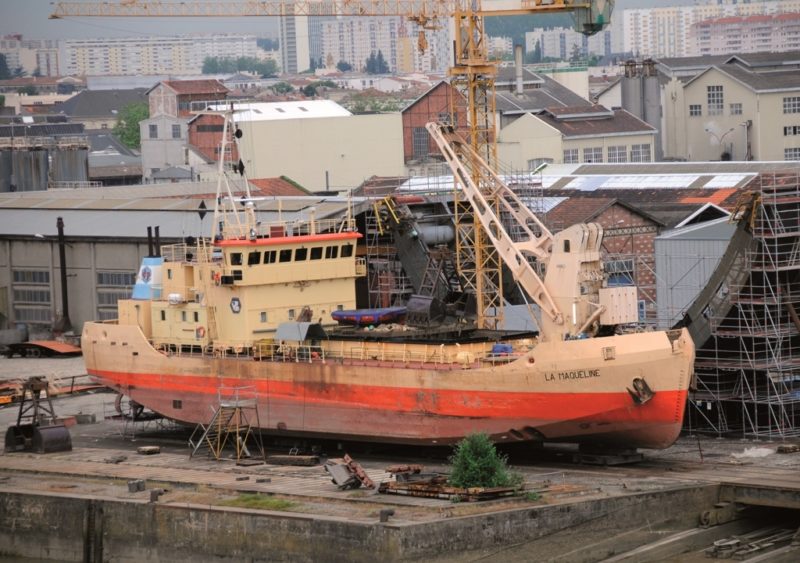
POSTSCRIPT
There were 57 cruise ship calls into the Gironde estuary in 2019, of which 48 berthed in central Bordeaux near the main tourist attractions. These included calls by Princess Cruises, Holland America Line, Fred Olsen Cruises, Seabourn Cruises, Silversea Cruises, Regent Seven Seas Cruises, Oceania Cruises, Phoenix Seereisen and Hapag Lloyd of Germany, Voyages to Antiquity, SeaDream Cruises, Crystal Cruises, Azamara Cruises and Saga Cruises. The ability to berth at a ‘green’ area in the centre of a UNESCO listed 18th century city is a big advantage to other ports.
The major cargo shipping companies that use the port today include Maersk Line, CMA CGM, MSC, OOCL, SDV Bollore Logistics, Worms Maritime Services, Wagenborg, Carl Buttner of Bremen, and Aggregate Industries (U.K.) Ltd. with self discharging bulk carriers Yeoman Bridge and Yeoman Bontrup, both of 96,725 dwt, and Yeoman Bank of 39,000 dwt, as well as the similar self discharging bulk carriers of Mibau + Stema of Germany including Beltnes, Bulknes, Fitnes, Sandnes, the twin screw Splittnes, and Stones of up to 33,000 dwt. These ships bring in infill cargoes of granite chips and stones to redevelop old port facilities, for road building and construction projects. Cargoes are diverse and include oil, chemicals and hydrocarbons, cereals, grain, timber, forestry products, coal, petroleum coke, containers, wines, liqueurs, brandy, sugar, potatoes and vegetables, manure, salt, high technology aeronautical and automotive components and braking systems, lasers, pharmaceutical products, food, drinks and alcoholic beverages, clothing, packaging, solar energy panels, mixed bulk cargoes of all types, aggregates, fertilisers, animal feed, oilseeds, and much more, arriving and sailing on 1,600 ships per year.
The rail networks to the seven ports and particularly to the main ports of Bassens and Le Verdon are extensive, with long loading and unloading tracks and ideal for inter-modal transfers of containers from roads. The Head Office of Bordeaux Port Atlantique was inaugurated in February 2012 at Bordeaux.
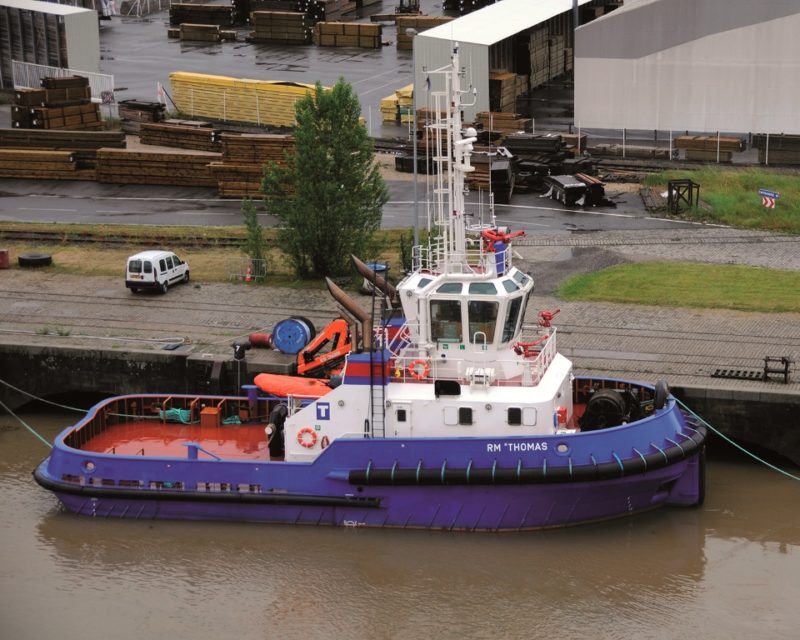





Comments
Sorry, comments are closed for this item